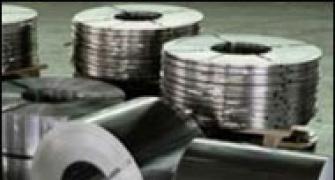Ferro alloy refers to various alloys of iron, which are used in the production of mild steel, carbon steel, special alloy steel and stain less steel. India's steel production is increasing every year, thereby the consumption of Ferro Alloys is also increasing.
 The Ferro Alloy industry has a capacity of 5.15 million tonnes. It is accounting for nearly 10% of the world's ferro alloy production and is among the 10 largest producers of the material in the world.
The Ferro Alloy industry has a capacity of 5.15 million tonnes. It is accounting for nearly 10% of the world's ferro alloy production and is among the 10 largest producers of the material in the world.
In the midst of raw material availability being a key factor for Ferro Alloy industry growth, production is concentrated in a few pockets. India, South Africa, China and the CIS countries represent a large source for Ferro Alloys.
India's Ferro Alloy supply constitutes of Ferro chrome about 32%, Ferro Manganese and Silicon Manganese about 62% and rest others.
India enjoys as fifth largest in chrome ore with a 100 million tonnes estimated reserve and the sixth largest in manganese ore with an estimated 176 million tonnes reserve.
|
Size of the domestic industry |
|||
|
|
Capacity |
Production |
Capacity utilization% |
|
Manganese Alloys |
3.16 |
1.93 |
61 |
|
Chromium Alloys |
1.69 |
0.9 |
53 |
|
Ferro Silicon |
0.25 |
0.13 |
52 |
|
Noble Alloys |
0.05 |
0.04 |
80 |
|
Total |
5.15 |
3.00 |
58 |
|
Provisional data in million tonnes during 2011-12 |
|||
Imports of Ferro Alloys have increased as and when the basic Customs Duty is reduced. The imports were Rs. 2,630 million when the duty was reduced from 25 % to 20 % in 2003-04, and increased to Rs. 4,793 million in 2004-05 when the duty was reduced to 15 %, and again to Rs. 5,913 million in 2005-06, when the duty was further reduced to 10 %, and Rs. 7,798 million when the duty was 7.5 % in 2006-07 and Rs. 10,894 million when the duty was 5 % in 2007-08 and Rs. 15,300 million during 2008-09, when the duty was further reduced to 0 % and Rs. 15,165 million in 2009-10 when the duty was 5 %, and imported Rs.27,627 million in 2010-11 and Rs. 33,923 million in 2011-12.
As a result, outgo of foreign exchange has increased to Rs. 1,02,909 million in last five years. This could have been avoided, and the requirement could have been met from the domestic production, by utilizing the idle capacity, which would increase the revenue from Indirect Taxes like Excise Duty, Sales Tax, etc. It would add to better utilization of investment in idle plants, create more employment and increase in GDP.
Raw material scenario
The Industry has enough capacity to produce Ferro Alloys required for domestic Steel Industry. However, certain basic raw materials, i.e., ores viz., ManganeseOre, ChromeOre, Molybdenum Ore/Moly Oxide, TungstenOre, Wolframite Ore, ScheeliteOre, Nickel Oxide, Vanadium ore, etc., required for producing Ferro Alloys are attracting an import Customs Duty of 2.5 %.
Manganese is an essential non –substitutable element in steel making. The twelfth Five-year plan has projected 128 million tonnes of crude steel by 2016-17.Considering the projected increase in steel production and demand of Manganese Alloys, the industry requires 6.08 million tonnes of Manganese Ore by the year 2016-17 to produce Managanese Alloys to cater to the domestic steel industry and meet their requirements. To produce 1 tonne of Manganese alloys, the required Manganese ore with 44% Mn is 2.40 MT for Ferro Manganese and 1.80 MT for Sillico Manganese.
|
Projected Demand Supply Gap of Manganese Ore during 12th Five Year Plan |
|||||
|
Year |
2012-13 |
2013-14 |
2014-15 |
2015-16 |
2016-17 |
|
Manganese Ore |
|
|
|
|
|
|
Production |
3,210 |
3,430 |
3670 |
3,930 |
4,200 |
|
Demand |
4,528 |
4,983 |
5,565 |
6,177 |
6,819 |
|
Demand Gap |
(-) 1,318 |
(-) 1,553 |
(-) 1,895 |
(-)2,247 |
(-)2,619 |
MOIL the major producer of ManganeseOre, is producing on an average 1 million tonnes per annum and partly meeting domestic requirement. At present Maharashtra Elektrosmelt (MEL), a Unit of SAIL is getting about 300,000 MT out of MOIL’s production. Two large captive Ferro Alloys Units being set up by MOIL at Raipur and Visakhapatnam in Joint Venture with SAIL and RINL, are expected to commence their operations in a year or two, require about 500,000 MT per annum. Thus, approximately 750,000/800,000 MT Manganese Ore out of MOIL raising is required to meet the demand of PSUs. Thus, MOIL will be left with hardly 300,000 to 400,000 tonnes of ManganeseOre for the Manganese Alloy Industry.
The Manganese Ore produced by other Mines in the country is low in grade and high in Iron content. Hence, these Ores are only suitable for blending with high Mn:Fe ratio Manganese Ores being supplied by MOIL to prepare suitable composition and to use in production of quality Manganese Alloys acceptable to the Steel industry within the country and abroad. If high grade with high Mn:Fe ratio ManganeseOre is not sufficiently available at a competitive rate from MOIL, the domestic consumers have no option except to source through imports. The Steel Industry being the backbone of economic development, the availability of required suitable quality of Manganese ore with a competitive rate assumes significance not only for the Manganese Alloy Industry, but also for the economic development of the country as a whole.
It is pertinent to mention here that Indian Ferro Alloys Industry has grappled with various issues, such as non-availability of power with competitive rate, suitable quality and quantity of ManganeseOre, minimum duty protection, etc. Besides, the Industry has to compete with the integrated producers having captive Manganese Ore Mines situated in South Africa, Australia, Brazil, CIS, etc., to sell acceptable quality of Manganese Alloys in the world market for earning the valuable foreign exchange for the country.
Ferro Manganese Slag is generated as a byproduct while producing Ferro Manganese. For every tonne of production of Ferro Manganese, approx. one tonne of Slag is generated. This slag is consumed in the production of Silico Manganese. The consumption of such slag for producing one tonne of Silico Manganese is 600 Kg. per tonne of Silico Manganese. Generally, Ferro Manganese is produced on high Mno Slag practice basis, i.e., above 38 % Mno in slag. However, considering the availability of low Mn/Fe ratio of Manganese Ores in the country, Ferro Manganese Producers are unable to produce Ferro Manganese with such high Mno2 slag.
The Industry produces 25 % of Manganese Alloys in the form of HC Ferro Manganese the rest 75% is Silico Manganese. Therefore, availability of slag is very low for producing Silico Manganese. The average consumption could be considered as 600 Kg. of Ferro Manganese Slag per tonne of Silico Manganese.
ChromeOre is a key, irreplaceable input for production of Chrome Alloys. The availability of resources of this strategic metalliferrous Ore is limited in the country. It is for this reason, that Government has been reviewing the Export Policy of Chrome Ore every year.
There is now only one major producer of ChromeOre in the country namely, Orissa Mining Corporation Ltd. (OMC), State owned Industry. Ferro Chrome Industry has to depend on their requirement of ChromeOre only from (OMC). The production from OMC is not adequate to meet the domestic requirement, being the single producer dictating monopolistic terms and prices.
Roasted Molybdenum Concentrate is imported by paying Duty of 2.5 % plus CVD. Roasted Molybdenum Concentrate is not manufactured in the country and it is 100% imported from other countries. There should not be any Customs Duty applicable for such import of raw material, which is not manufactured within the country. With 5 % Import Customs Duty on Ferro Molybdenum, there is hardly any gap between raw material and Finished goods Duties, specially if 2 % CST (Effective CST 2.206%) is considered.
Raw Material for Ferro Vanadium: Process of Ferro Vanadium manufacturing starts from Vanadium Sludge/other vanadium bearing raw materials which is processed and converted into Ammonium Meta Vanadate and then further processed for conversion to Vanadium Pentoxide, which is then used along with other raw materials for manufacturing Ferro Vanadium.
As the value addition is very less in conversion of Vanadium Sludge / Ammonium Meta Vanadate/ Vanadium Pentoxide to Ferro Vanadium. The Special Additional Duty (SAD) of 4 % is getting accumulated, which is blocking working capital of the manufacturer. It is necessary that SAD should be removed for such imports. Since 75 % of the raw material is imported, it is suggested that the Customs Duty for the same may be brought down to Nil percentage from 2.5 %.
Reductants viz. Anthracite Coal, Coke, Charcoal, Non-Coking Coal and Lignite, are vital Inputs for the Ferro Alloy Industry as well as Pig Iron Industry. The consumption of these Reductants for producing one tone of Ferro Alloys varies between 600 to 2,000 Kgs, depending on the Ferro Alloys produced. The availability of these items in good quality is declining in the country and the Ferro Alloy Industry may have to totally depend on import of these Reductants on regular basis.
Industry Expectations
- To list Ferro Manganese Slag under free items instead of restricted items.
The demand of Ferro Manganese Slag works out to around 851,306 tonnes, whereas considering the Ferro Manganese production, the availability of Slag would be around 320,561 tonnes (75 % of Ferro Manganese production is considered as High Mno Slag production process). Thus the demand supply gap would be around 530,745 tonnes during this year. This will increase in the coming years, considering the projected increase in Steel production and the demand of Silico Manganese. Hence, Industry recommends to list Ferro Manganese Slag under free item instead of restricted items,
- To increase the Customs Duty on Ferro Alloys to 7.5% except Ferro Nickel.
The present Duty on Ferro Alloys is 5 %. But this is not sufficient, as the import of Ferro Alloys is increasing every year, when the domestic Industry is working at around 60 % capacity leaving balance 40 % lying idle. The Industry fears that there will be cheap imports from other countries with the import Duty on Ferro Alloys at 5%.The Industry needs a level playing field by supplying power at international price. The power tariff is 3 to 5 times higher as compared to the power tariff available in other Ferro Alloy producing countries.
These costs disadvantage encourages other countries to export Ferro Alloys into India at very low prices when the Duty is also at a lower level in the country. Therefore, industry recommends to increase the basic Customs Duty from 5 % to 7.5 %. With this, Government’s revenue will also increase by levying higher import Customs Duty.
- To waive Customs Duty on raw materials i.e., ores and for production of Ferro Alloys.
The reduction in Customs Duty of Ferro Alloys, without reduction in the Duty of Ores , was certainly an oversight , since the difference between the Custom Duty of Ferro Alloys and Ores is now at 2.5% which almost nullifies , due to Central Sales Tax of 1% to 2% for domestic supplies.
The import of Raw Material - ManganeseOre, ChromeOre, MolybdenumOre and Vanadium Oxides are negligible. These raw materials are very essential for producing Manganese Alloys, Chrome Alloys, Ferro Molybdenum and Ferro Vanadium respectively, to cater to the Steel and Stainless Steel Industry in the country. As the Steel production increases, the requirement of Manganese Alloys, Chrome Alloys, Ferro Molybdenum and Ferro Vanadium will increase and so also the Raw Materials to produce the Alloys. Therefore, IFAPA recommends, Government to reduce the Custom Duty of Ores, from existing 2.5% to 0%.
- To waive Import Customs Duty on Anthracite Coal.
The basic Customs Import Duty on Anthracite Coal is 5 % with CVD of 6 %.Since Ferro Alloy Industry plays a vital role in the manufacture of Steel, it is necessary for Government to make available these Reductants at international competitive price. Government has considered industry’s request in the past and reduced the Customs Duty on Metallurgical Coke to 0 %.
Stocks to Watch: Nava Bharat Ventures, Rohit Ferro Tech, Ferro Alloy Corporation, Indian Metals and Ferro alloys
Analyst Expectations:
Ferro Alloy Industry in the country was demanding a hike in the import duty of Ferro Alloys from last two years. But , this was not taken into consideration by the Government till now. Though the Ferro alloys producers have expanded their installed capacity from 4.65 million tonnes in 2010-11 to 5.15 2011-12 , to meet the expected rising demand from steel industry , but cheap imports from China and other countries is steadily grabbing the domestic market share.
According to the IFAPA , the advantages of the demand is muted. This is because of escalating imports from other countries and there by , an imminent reduction in the capacity utilization. According to the recent data, the capacity utilization dropped from 62% in 2010-11 to 58% in 2011-12. Ferro Alloy’s production in India stood at 3 million tonnes in 2011-12 , showed a marginal increase of 0.13 million tonnes compared to the previous year.
Besides, the imports of Ferro Alloys increased by 25% to 271,896 tonnes while, in value terms, it increased by 23% to Rs. 24,95.57 million in 2011-12 compared to 2010-11. Therefore, it is necessary to increase the import duty from 5% to 7.5% to protect the domestic industry from cheap imports.
On the other hand , the raw materials such as ManganeseOre, ChromeOre, MolybdenumOre and Vanadium Oxides which are currently attracting an import duty of 2.5% , are very essential in manufacturing Ferro Alloys and thereby to cater to the Steel and Stainless Steel Industry in the country. The reduction in Customs Duty of Ferro Alloys, without reduction in the Duty of Ores, is not beneficial to the industry. Hence, it is also necessary to waive the custom duty on Ores in the Union Budget 2013-14.
Outlook
The custom duty on Ferro alloys if increased from 5% to 7.5%, the imports from other countries would reduce and thereby paves the way for the industry to utilize the idle capacity which would in turn increase the Government revenues from indirect taxes.
Also, the raw material custom duty if reduced from 2.5% to 0%, the imports would increase on cheaper price and thereby the requirements of the industry will be met adequately. Improved production at reduced costs on one side and escalating steel industry with the higher products prices is certainly going to benefit the Ferro Alloy industry on a whole in medium to long term.
Given the gloomy outlook scenario in Euro zone countries and steady demand in China, the demand and the realization of Ferroalloys is expected to be at the same level in near term.








